FIRST YOU READ, THEN YOU WRITE
by Francis M. Nevins
I can hardly believe it but we are less than six months away from the 60th anniversary of the debut of Perry Mason the TV series. It was a Saturday evening, September 21, 1957, and among the millions of viewers whose sets were tuned to CBS at 7:30 P.M. Eastern time was a bookish 14-year-old, just beginning his second year of high school, who had discovered and gotten hooked on Erle Stanley Gardner’s Mason novels several months earlier.
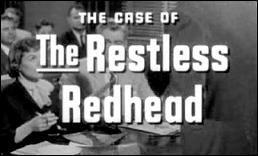
For the next few years I watched the program religiously, catching most of the finest episodes and almost all of those that were at least nominally based on Gardner’s novels. By the time I began dating on Saturday nights the series had become humdrum and routine, at least to my taste, but it remained in prime time for an amazing nine seasons, and countless viewers still identify Gardner’s characters with their TV incarnations: Raymond Burr (Mason), Barbara Hale (his secretary Della Street), William Hopper (private detective Paul Drake), William Talman (DA Hamilton Burger), and Ray Collins (Lt. Tragg).
To mark the occasion, if a bit prematurely, I’m going to devote most of this column to the first episode aired and the book it was taken from.
***
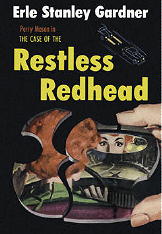
First, the book. The Case of the Restless Redhead (1954) opens with Mason happening upon a trial for larceny in suburban Riverside. Evelyn Bagby, a near-broke waitress with Hollywood dreams, is accused of having stolen $40,000 in jewelry from the trunk of Irene Keith, a wealthy businesswoman on her way to Las Vegas to be bridesmaid at the wedding of movie star Helene Chaney and boat manufacturer Mervyn Aldrich.
Seeing that assigned defense counsel Frank Neely is out of his depth cross-examining the witness who claims to have seen Bagby open the trunk, Mason over lunch offers the young man a few pointers. That afternoon Neely demolishes the prosecution witness and wins a verdict of acquittal. Bagby comes to Los Angeles to thank Mason and they discuss whether she’s entitled to compensation from Keith, who signed the complaint against her.
Bagby suggests that she might have been framed for the jewel theft because she’d recognized a newspaper photo of Chaney’s former husband as the phony drama coach who had swindled her out of her inheritance several years before and whom she had called, demanding restitution. Mason gets her a job as waitress at the Crowncrest Inn, which is on a mountaintop connected with the metro area by a narrow and desolate road.
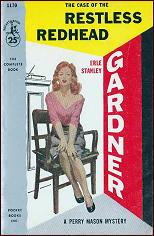
That evening Bagby calls Mason and claims to have found a .38 Colt Cobra with a 2-inch barrel planted in her room at the Inn. Mason tells her to meet him at a certain restaurant, bringing the gun. When they get together she says she was attacked on the mountain road by a man wearing a pillowcase mask, at whom she fired two shots with the .38. Mason reports to the authorities. When he, Della, Bagby and an officer visit the scene of the incident, they find a wrecked car and inside it a dead man, shot in the head and wearing a pillowcase mask.
When it’s discovered that the mask came from the Crowncrest Inn, and that the dead man was in fact the fake drama coach who had cheated her, Bagby like all Mason’s clients gets charged with murder. Much of the rest of the novel takes place at the preliminary hearing where Mason defends her.
Looking at the plot through a microscope reveals flaws here and there. As the hearing begins, the decedent’s body is identified not by the police or a medical examiner but by one of the characters, who isn’t needed as a witness but whom Gardner needs in the courtroom later.
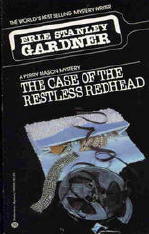
At the end of the book Mason “deduces†a good bit of the plot without a shred of evidence to go on. There are other holes too but they didn’t faze Anthony Boucher and I didn’t let them bother me much either. Boucher in the Times Book Review (7 November 1954) said: “Some intricate defensive maneuvers to confuse the ballistic evidence may baffle not only the judge and the prosecution but also the reader; you’ll have to keep your mind as sharp and devious as Mason’s own to follow this one, but it’s a wonderful roller-coaster ride.â€
For the sake of those who don’t want to have the novel spoiled by my saying too much about the plot, I’ll let the cat out of the bag in a paragraph which will remain hidden unless you click on it. Here, kitty!
***
The telefilm with which the Mason series debuted keeps the ballistic maneuvers pretty much intact but simplifies the novel in almost every other way imaginable. Irene Keith is dropped, as are fledgling lawyer Frank Neely and his fiancée and the whole larceny trial with which the book opens. The rationale for the titular adjective, that Bagby likes to keep moving from one place to another, winds up on the cutting-room floor, leaving us with nothing but alliteration for its own sake.
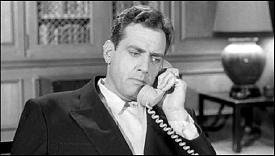
Bagby’s bullets, which in the novel complicate the plot by striking certain objects, on the small screen hit nothing. The ballistic testimony which dominates several chapters of the novel is cut to the bone. But with something like 52 minutes of air time to do justice to a full-length book, what option other than cutting was available?
All in all, adapter Russell S. Hughes did a creditable job. It was the only teleplay he wrote for the series. Before the first season’s end, he had died. Age 48. Cause unknown.
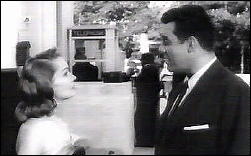
Raymond Burr as Mason is spectacularly slender, having reportedly lost between 60 and 100 pounds while preparing for the part, and smokes up a storm, as do several other characters including his client, who is seen finding the planted .38 in her cigarette box. The client was played by lovely Whitney Blake (1926-2002), who will also pop up later in this column.
Prominent in the cast were Ralph Clanton (Mervyn Aldrich), Gloria Henry (Helene Chaney) and Vaughn Taylor (Louis Boles). The first several minutes could be mistaken in dim light for film noir, thanks especially to ominous background music by the never-credited Ren Garriguenc (1908-1998), whose talent (when he wanted to exercise it) for sounding like his CBS colleague Bernard Herrmann has fooled experts. Bits and pieces of Herrmann music are heard here and there but they are few and far between.
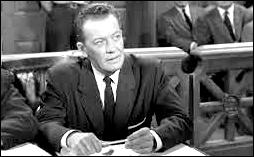
About the director, William D. Russell (1908-1968), not a great deal is known. He began making movies after World War II at Paramount, where he helmed several “heartwarming†comedies. During a pit stop at RKO he made Best of the Badmen (1951), a Western starring Robert Ryan, Claire Trevor, Robert Preston and Walter Brennan, which can be seen complete on YouTube.
Like so many directors of his generation who saw their careers crumbling thanks to TV, he embraced the new medium and began specializing in situation comedies, directing 61 episodes of Father Knows Best before moving to CBS. There he took up more serious fare, notably a few early episodes of Gunsmoke and 28 of Perry Mason.
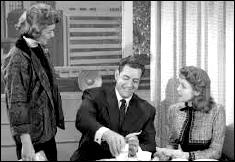
Afterwards he went back to the sitcom, directing 48 segments of Dennis the Menace and 128 of the 154 episodes of Hazel (1961-66), starring Shirley Booth as live-in housekeeper for an affluent family, the female head of which was played by — I told you she’d pop up again! — Whitney Blake. (Whether she arranged for Russell to come aboard, or vice versa, or whether it’s just a coincidence, remains what Russell concentrated on for a few years and then dropped: a mystery.) Less than two years after the series was cancelled — which happened the same year Mason was cancelled— Russell died. Age 59. Cause unknown.
***
On top of all his novels and stories and travel books and Court of Last Resort pro bono work on behalf of the wrongfully convicted, Erle Stanley Gardner kept up a gargantuan correspondence. One of his correspondents was Harry Stephen Keeler (1890-1967), the wackiest wackadoodle who ever sat down to a typewriter. Several of Harry’s multi-colored “Walter Keyhole†newsletters, assembled and arranged by me in The Keeler Keyhold Collection (2005), include quotations from ESG’s letters to him.
In one of them, probably dating from the late Fifties or early Sixties, Gardner alluded to the fact that both his mother and Keeler’s happened to have the same first name; an odd one to say the least. “Now ‘Adelma’ [Keeler wrote] is not a recognized name….Name experts say that it is undoubtedly an artificial synthesis, or fusion, of the names ‘Adeline’ and ‘Thelma’.â€
Why not Adelaide, or Selma? After comparing notes, the two discovered “that a grandfather of each had been in the Civil War†(presumably on the same side) and concluded that “over some camp fire their grandfathers must have met, and talking of possible ‘odd’ names for girl-children, agreed…to name their first daughters ‘Adelma’.†Well, maybe. Anyway it’s a good story.








